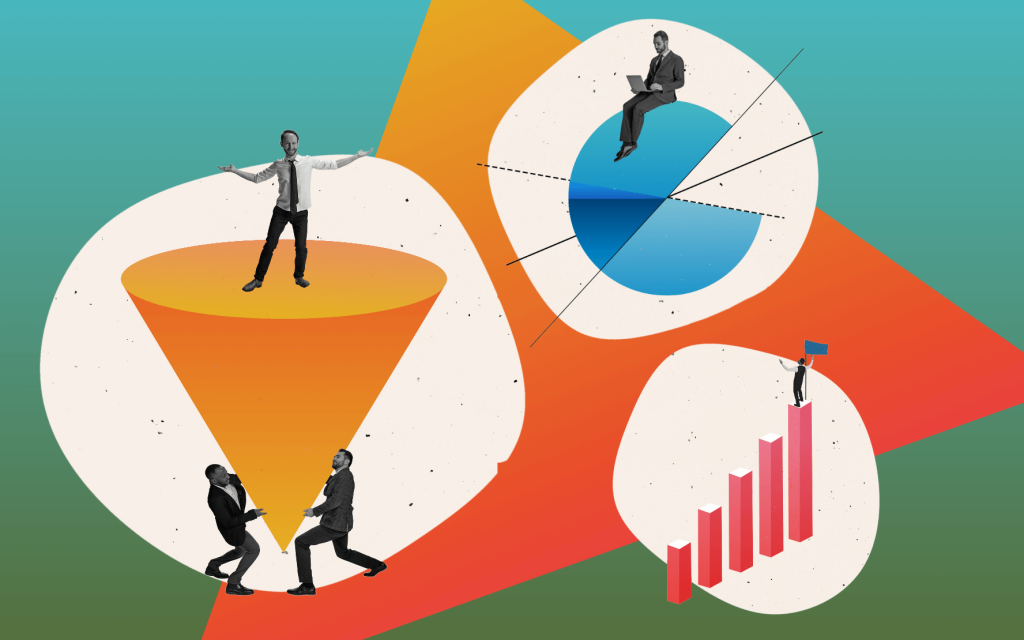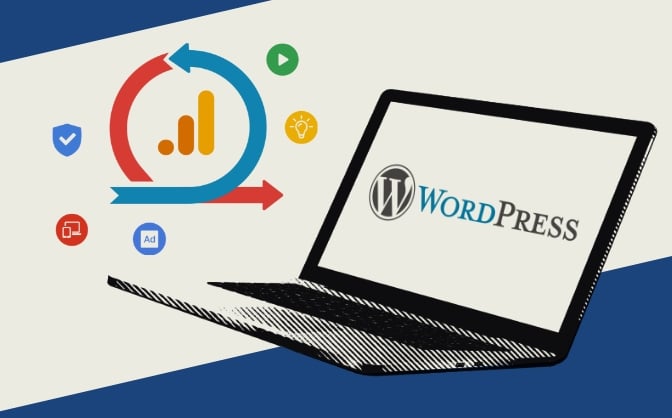Business Analytics in Marketing: A How-to-Guide
B2B Marketing
Elevate your business analytics efforts by understanding its unique factors and how to implement them in your strategy.

Ever noticed how we often split marketing analytics from business analytics? Sure, it allows us to dive deep into each field, but sometimes we miss the bigger picture.
If you’re the one reporting marketing results to the C-levels, you know it’s not just about the data, but what that data means for your business. A critical aspect of any successful business model, business analytics are the key to understanding your customers, creating highly effective campaigns, and maximizing your ROI.
Purpose and Definition of Business Analytics
Business analytics is the process of comparing, sorting, and analyzing data, and then using algorithms or statistical models to draw insights and make informed business decisions.
Think of business analytics like a compass for your business, guiding you to the most important stuff using solid, real-deal data.
This data isn’t just any data. It’s got to be the 3 R’s: Real, Relevant, and Reliable.
Applying business analytics to marketing is like having a bird’s-eye view of your business landscape. It helps decision-makers see the bigger picture and avoid getting lost in the details
Understand Data Collection
When it comes to business analytics in marketing, data collection is the foundation on which everything else is built, and understanding the different types of data is key when it comes to strategic decision-making. So without further ado, let’s dive into the different types of data and how to gather them.
- First-party data: This is the data you collect directly from your customers and prospects. It includes demographics, purchase history, consumer behavior, website interactions, and email engagement. It’s valuable because it’s unique to your business and provides a clearer picture of your specific audience.
- Second-party data: This is data collected by another organization but shared with you. It can help expand your target audience or provide new insights.
- Third-party data: This data is collected by external sources such as market research companies, government agencies, or data aggregators. Aggregation of data from these sources can provide valuable insights into broader industry trends and benchmarks.
Now let’s talk about how data is collected. There are two primary methods: active and passive data collection.
- Active data collection involves proactively seeking information from your audience. This can be done through surveys, interviews, focus groups, or feedback forms. Active data collection allows you to gather specific insights tailored to your research questions.
- Passive data collection, on the other hand, involves collecting data without direct interaction with your audience. This includes tracking website and data analytics, monitoring social media engagement, or analyzing customer behavior through cookies. Passive data collection provides a continuous stream of information without requiring active participation from your audience.
Understand A/B Testing
A/B testing, also known as split testing, is a method used in marketing analytics to compare the performance of two versions of a marketing element.
Here’s how it works: Let’s say you want to test if changing the color of a call-to-action button on your website increases click-through rates. You create two versions of the webpage: one with the original button color (A) and another with the new button color (B).
Next, you randomly divide your website visitors into two groups, with one group seeing version A and the other seeing version B. By tracking user behavior with metrics like click-through rates or conversions, you can measure the impact of each version.
The key to effective A/B testing is isolating the variable you want to test while keeping other factors constant. This helps you gather evidence for or against your hypothesis and make data-driven decisions.
Remember, A/B testing is an iterative process. Learn from each test and gradually optimize your marketing strategies for better performance.
Understand Correlation and Causation
It’s important to differentiate between correlation and causation when analyzing data.
Correlation means that two factors are associated with each other. Changes in one are linked to changes in the other. For example, if ice cream sales increase and sunglasses sales also increase, there is a positive correlation. However, correlation alone does not imply a cause-and-effect relationship. That doesn’t mean selling ice cream causes more sunglasses to be sold. Correlation simply shows that as one goes up (or down), so does the other.
Causation, on the other hand, indicates a direct cause-and-effect connection between two factors. Now, let’s say you run an A/B test on your website. Half of the visitors see a promotion offering “buy ice cream and get 50% off sunglasses,” while the other half see the regular website without any promotion. If the group exposed to the promotion causes a significant increase in sunglasses purchases, you can establish causation. By controlling variables and conducting the experiment, you can confidently conclude that the ice cream promotion caused the increase in sunglasses sales.
Understanding the difference between correlation and causation is crucial for drawing accurate conclusions from your data analysis.
Understand Distribution, Confidence, and Regression
In addition to correlation and causation, there are other important business analytics terminologies to grasp: distribution, confidence, and regression.
Distribution: Distribution plays a crucial role in A/B testing by determining how many people, or data samples, are exposed to different versions.
Imagine you’re a teacher and you want to understand the performance of your students on a recent test. After grading the test, you plot the scores in a histogram. The scores mostly cluster around 85-90, a few are between 90-100, and a handful are below 85. This is your data distribution. It shows you the spread and central tendency (most common score) of your student’s test performance.
Confidence Interval: The confidence interval helps you gauge how reliable the data you observe in a test is, ensuring it’s not just a coincidence or prone to random fluctuations.
Let’s say you run a small coffee shop and want to know the average amount of coffee your customers drink daily. It’s not feasible to ask every single customer, so you select a random sample of 100 customers and find the average from their responses. Now, you can’t be 100% sure that this average applies to all your customers, but you could be 95% confident. This is your confidence interval; it indicates how certain you are that your sample data represents the entire customer base.
Regression: Regression analysis is frequently employed to forecast outcomes based on the causal relationship between two factors. However, it’s important to note that regression analysis can accurately predict results only when a causal relationship exists between the variables, rather than a mere correlation.
Imagine you’re a sales manager trying to predict next month’s sales based on the advertising spend. You put past-month data of sales against advertising spend and notice a pattern — as advertising spending increases, so do the sales. You can fit a line (regression line) through this data to predict future sales based on the advertising budget. This process of predicting future outcomes based on historical data using regression analysis can be considered a form of predictive analytics.
SWOT – The Most Used Business Analytics Model
Now that we’ve covered the basics of business analytics in marketing, let’s dive into one of the most popular and effective models used for analysis: SWOT.
SWOT stands for Strengths, Weaknesses, Opportunities, and Threats.
- Strengths: These are the internal factors that give your business a competitive advantage over others in the market. Think about your unique selling points, valuable assets, and expertise that set you apart.
- Weaknesses: These are also internal factors that may hinder your success, such as limited resources, outdated technology, or gaps in skills or processes.
- Opportunities: These are external factors that present potential advantages for your business. Look for emerging trends, market changes, new customer segments, or untapped niches that you can leverage for growth.
- Threats: These are also external factors that pose risks or challenges to your business. Consider competition, market volatility, changing regulations, or any obstacles that may impact your operations or market position.
Using SWOT analysis in marketing allows you to develop a comprehensive understanding of your business landscape and make informed decisions.
SWOT Real-World Example: How Shein Wins Fast Fashion Domination with Gen Z
To explain SWOT, let’s take a look at the new fast-fashion brand Shein, an online brand with a massive selection of stylish clothes, accessories, and more. Shein has become a go-to destination for cheap fashion.
Let’s take a look at the SWOT analysis for Shein:
Strengths:
- Vast Design Options: Shein can create a few million design variations a month.
- Affordable Pricing: With vast manufacturing relationships, its fashion pieces cost as cheap as $8, while competing brands cost around $15-$20+ per item.
- Agile Supply Chain: Because of the low merchant cost, Shein can afford direct shipping from manufacturers to customers with a fast turnaround.
Weaknesses:
- Product Consistency: Because of the low cost, some products are not consistent in sizing standards.
- Limited Sustainability Initiatives: Drop-shipping adds to the company’s carbon footprint.
Opportunities:
- Expanding Global Reach: With e-commerce growth and its supply chain capability, Shein can sell to anyone anywhere.
- Large and Growing Demand: Gen Z craves new and cheap fashion pieces.
Threats:
- Huge competition: fashion is a competitive space with a lot of alternatives and not-so-loyal customers.
- Low brand awareness: no one knew Shein when they started – they didn’t have a glamorous founder or designer.
- Reputation Management: Negative reviews and controversies surrounding product quality and ethical concerns have impacted their brand reputation.
Strategies for Leveraging Strengths and Opportunities
Shein has strategically applied the SWOT analysis to shape its marketing and business strategies, focusing on leveraging its strengths and capitalizing on opportunities.
Here’s how they’ve done it:
- No store: Shein recognized its strength in selling exclusively online, allowing them to keep costs low by eliminating the need for brick-and-mortar stores.
- Data-driven design: Shein hires data scientists to design and launch new clothing at an impressive pace. This also allows them to focus on the designs that were appealing to customers based on previous sales. This approach, known as data science, helps them stay on top of trends.
- Significant product rotation: To put this in perspective, according to the Indicator Podcast, while H&M and Zara introduced 25,000-30,000 products at once, Shein at one point introduced 1.3 million new products.
- No restocking: To further leverage its manufacturing and design strength, Shein follows a unique strategy of not restocking products. When an item sells out, it is replaced with a fresh selection with 100x as many new variants.
- Adopting drop-shipping: By shipping products directly from suppliers to customers, they bypass the need for a large inventory, reducing shipping risks, and mitigating delays.
- Leveraging social media (especially TikTok): Shein recognizes that Gen Z and fast fashion enthusiasts are active on social media platforms. To reach this target audience, they have strategically promoted their brand through platforms like TikTok.
How to Use SWOT to Guide Your Marketing Strategy
Now that we’ve seen how Shein successfully utilizes SWOT analysis to shape its strategies, let’s explore how you can use SWOT to guide your own marketing strategy.
Understand Your Strengths and Weaknesses
Conducting internal surveys and data collection can help you uncover your company’s strengths and weaknesses.
One effective approach is to interview key customers. Listen to why they chose to work with you or buy from you (S), understand their perception of alternative brands (T), and identify any concerns they may have (W & T), and learn why they appreciate or refer to your business (S & O).
The more comprehensive and diverse your sample size, the better the insights.
Analyze and Clean Up the Data
Once you have collected the necessary information, analyze it and categorize the findings into the four areas of SWOT: Strengths, Weaknesses, Opportunities, and Threats.
This step allows you to gain a clear understanding of the internal factors that can positively or negatively impact your marketing efforts.
Identify Focus Areas
After categorizing the data, identify the areas where you should focus to magnify your strengths (SO) or minimize your weaknesses (WT).
Apply SWOT to Your Own Marketing: Example 1
- Strength: Customer testimonials consistently highlight your excellent customer service and product quality.
- Weakness: Limited brand awareness in a competitive market.
- Opportunity: A growing demand for eco-friendly products.
- Threat: New competitors entering the market.
In this scenario, you can leverage your strong customer service for the best customer experience and product quality as key differentiators in your marketing campaigns.
If you haven’t gotten any testimonials, make an effort to get some in the form of reviews, before/after images, videos, case studies, or on third-party websites. This helps build trust and credibility with potential customers.
Simultaneously, explore opportunities in the eco-friendly product segment to tap into the growing market demand.
This can be your key focus on content marketing efforts and dedicating resources to research and develop eco-friendly products. This demonstrates your commitment to sustainability and resonates with the growing demand for environmentally conscious choices.
At the same time, you may need to be vigilant about the threat posed by new competitors and take proactive steps to protect your market share.
Apply SWOT to Your Own Marketing: Example 2
- Strength: Extensive experience and expertise in a specific industry.
- Weakness: Limited online presence and outdated website.
- Opportunity: Increasing digital adoption and online customer engagement.
- Threat: Industry disruption due to technological advancements.
In this case, you could prioritize enhancing your online presence and revamping your website to leverage the increasing digital adoption and engage with customers effectively.
Hire a capable marketing team or vendor to turn this weakness into a strength. Someone who can help you modernize your website and optimize it for user experience and search engine visibility.
Additionally, you can utilize your industry expertise to differentiate yourself from competitors and stay ahead of industry disruptions caused by technological advancements. Do your customers know about your expertise? How does expertise matter to your customers? Use this knowledge to rebrand, or pinpoint value propositions aiding in your acquisition campaigns. This could be the biggest touchpoint in your PPC, inbound/outbound marketing activities, and other digital marketing approaches.
At its core, business analytics is all about using real, relevant, and reliable marketing data to identify what’s important and make better business decisions.
Don’t just let big data sit there. Use it, learn from it, and let it inform your strategies. And if at any point you feel overwhelmed or need help navigating these strategic discussions, don’t hesitate to reach out.
Happy analyzing!
Learn from each test and gradually optimize your marketing strategies for better performance.
At its core, business analytics is all about using real, relevant, and reliable marketing data to identify what’s important and make better business decisions.
The Latest

Predictive Analytics: As AI Comes of Age, Marketing Strategies Mature
Predictive analytics is the future of marketing. Learn how AI is helping marketers connect.

The 10 Important B2B Marketing KPIs for Lead Generation
Boost your B2B lead generation with these KPIs for optimal success.

How to Switch From UA to GA4
The definitive guide to migrating your UA data to GA4.